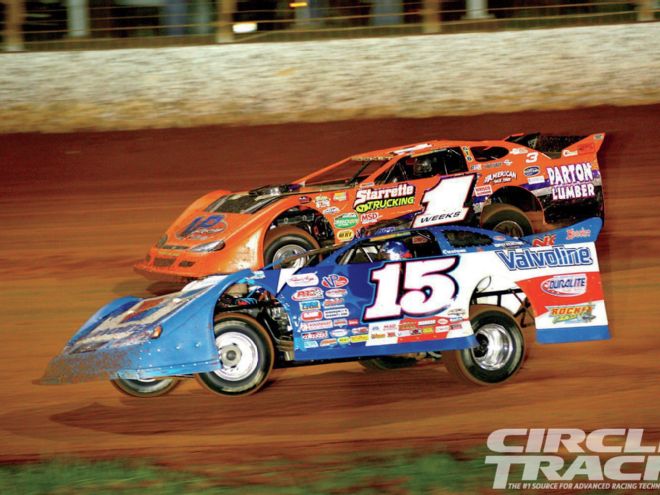
Rear Steer in a race car is an effect that is mostly caused by suspension movement. Under the right conditions in measured amounts, RS can be beneficial and enhance performance. Under the wrong conditions, it can ruin your handling. We need to have a solid understanding of what produces RS and what effect RS has on the handling in our cars in order to have the best performance.
When we have rear suspension movement, as the rear corners of the car move, along with the controlling arms that locate the rearend fore and aft, the components for each side can move the wheel either forward or to the rear.
A rearend that is steered to be pointed to the left of centerline will cause the thrust angle to be left of centerline and make the car tighter on entry and tighter on exit under acceleration. A rearend that is steered to the right of centerline causes the thrust angle to be pointed to the right of centerline and makes the car looser on entry and looser on exit under acceleration.
The asphalt racing surface provides a lot of traction, even on those flat “slick” tracks. Because there is very little slip of the tires on asphalt, the range of useable rear steer is very small. There are six predominant rear suspension systems used in stock car racing and all of them produce some amount of rear steer. They are:
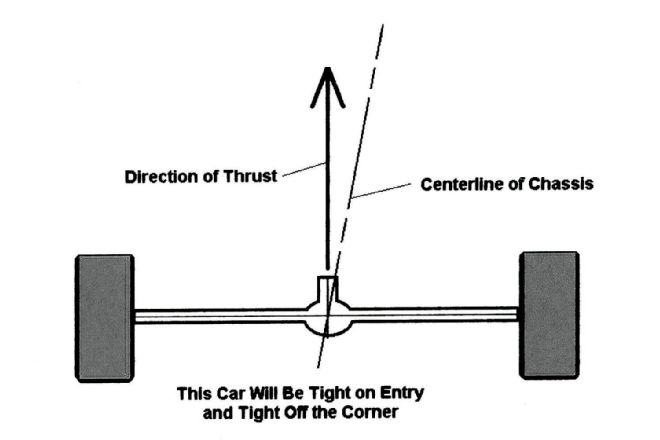 With the rearend pointed to the left of centerline, the steering will cause the rear of the car to want to run under the front end causing a very tight condition, especially under acceleration. With the rearend pointed to the right of centerline, the car will be freed up going in, through the middle and possibly loose off the corners with the rearend wanting to run around to the right of the front.
With the rearend pointed to the left of centerline, the steering will cause the rear of the car to want to run under the front end causing a very tight condition, especially under acceleration. With the rearend pointed to the right of centerline, the car will be freed up going in, through the middle and possibly loose off the corners with the rearend wanting to run around to the right of the front.
The Three-Link System
This system has two trailing arms mounted near the rear tires and one third link, usually mounted atop the rear differential, that controls rearend wrap-up. The trailing arms can be mounted parallel to the centerline of the car or angled with the front mounts closer to centerline. They can also be mounted at different angles from a side view.
RS in this system is caused by chassis movement which can produce several secondary effects. Usually, the right rear corner of the chassis moves more than the left side, and on most flat to medium banked tracks, the left rear moves very little.
On most asphalt three-link cars, the RR trailing arm mostly controls RS due to body roll. We usually need to position the angle of the trailing arm so that the front mount is higher than the rear mount by roughly one-third the distance that the front mount will move down during cornering.
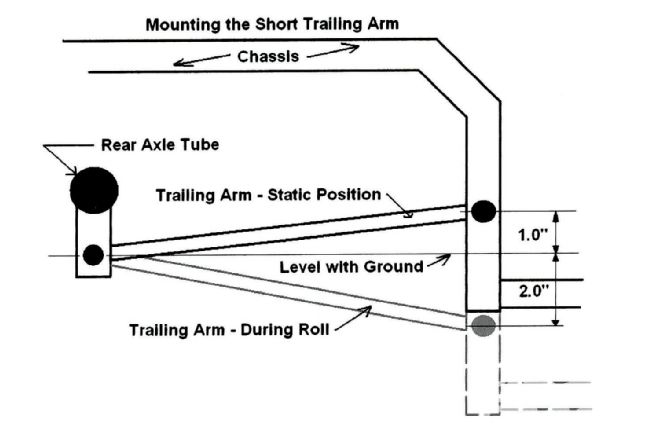 The three-link rear suspension system can produce rear steer in both directions. As the chassis moves down on the right side, the RR wheel will be moved back as the front mount approaches the height of the rear mounting point. As the front mounting point continues to move down, the RR wheel will be pulled forward. Normally, to produce a small amount of rear steer to the left on asphalt, we mount the front pivot point 1/3 of the total travel distance higher than the rear pivot.
The three-link rear suspension system can produce rear steer in both directions. As the chassis moves down on the right side, the RR wheel will be moved back as the front mount approaches the height of the rear mounting point. As the front mounting point continues to move down, the RR wheel will be pulled forward. Normally, to produce a small amount of rear steer to the left on asphalt, we mount the front pivot point 1/3 of the total travel distance higher than the rear pivot.
The Truck Arm System
The truck arm system has been adapted from the design of 1964 Chevy pickup trucks and is used on many Late Model Stock cars as well as the three premier divisions of NASCAR—the Camping World Trucks, Nationwide, and Sprint Cup cars. These systems only steer to the left and have a limited amount of steer. The roll of the chassis and the movement of the Panhard bar are the two components that influence the amount of steer in these systems.
As far as geometry related to rear steer is concerned, this is a good system for asphalt cars. The amount of rear steer due to body roll is regulated by the height of the front mounts of the arms which are always mounted lower than the rear point of rotation, which is the axle. Rear steer amounts due to the Panhard bar’s vertical movement are regulated by the angle of the bar.
The Standard Four-Bar System
The four-bar suspension is highly adjustable and can be made to steer in both directions. The rule about never steering the rearend to the right on an asphalt car does not apply to a dirt car. There are times when we definitely want the rear to steer to the right.
To determine the amount and direction of rear steer in this system, we must know the movement of the corners of the car. On dirt cars, this can be very different than what we see on asphalt cars.
The Metric Four-Link System
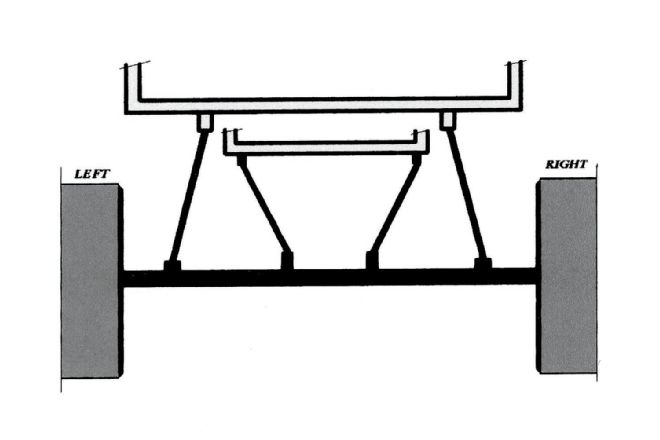 The Metric four-link suspension has two links above the rearend and two links below the rearend. They are angled from a top view to prevent the rearend from moving side to side as the chassis experiences lateral loading through the turns.
The Metric four-link suspension has two links above the rearend and two links below the rearend. They are angled from a top view to prevent the rearend from moving side to side as the chassis experiences lateral loading through the turns.
The metric four-link is a widely used system that comes with some models of stock automobiles. It uses four links, as the name implies, that are not parallel to the centerline of the car. The top links are angled from a top view with the front pivots wider than the rear pivots. The lower links are angled from a top view with the front pivots narrower than the rear pivots.
With this system, the rearend stays located by virtue of the opposing angles of the upper and lower links. There may be rear steer inherent in this system depending on the ride heights because the original car was designed for stock ride heights. When we race a stock car, we usually change the ride heights. Under most current rules, there is no adjustment for amounts of rear steer with these systems.
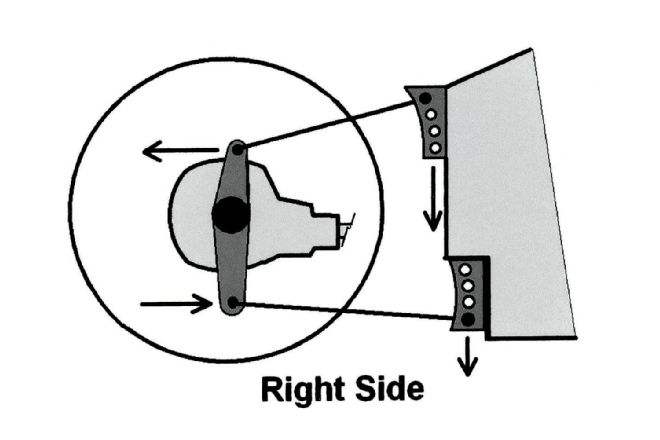 If the bars on a four-bar car are set in the correct holes, the movement of the top and bottom mounts at the rearend will compensate fore and aft resulting in zero rear steer. This is best for tight, tacky tracks where we do not need rear steer and we need for the thrust to be pointed straight ahead.
If the bars on a four-bar car are set in the correct holes, the movement of the top and bottom mounts at the rearend will compensate fore and aft resulting in zero rear steer. This is best for tight, tacky tracks where we do not need rear steer and we need for the thrust to be pointed straight ahead.
Leaf Springs Systems
The leaf spring rear suspension system locates the rearend fore and aft as well as laterally using the leafs. There can be a small amount of rear steer as the chassis rolls and squats, but it is both minimal and mostly fixed as far as adjustability. The advantage of this system is that it keeps the rearend squared up and the thrust under acceleration straight ahead, if that is what is needed.
The height of the front eye of the leaf spring in relation to the axle centerline determines the amount of rear steer. Spacing the leaf different heights from the axle tube can be a way to change the height relationship of the front eye and the axle, which will change the amount of rear steer for this system.
The Z-link System
The Z-link rear suspension, or swing arm as it is sometimes called, is another system used on dirt cars. Compared to the four-bar cars, it has more limited adjustment for rear steer and historically has worked well on the tighter and more highly banked racetracks because the direction the rearend is pointed is more straight ahead.
Some manufacturers have added multiple mounting points on the front and rear chassis mounts. This helps make the rear steer characteristics more adjustable for the changing conditions.
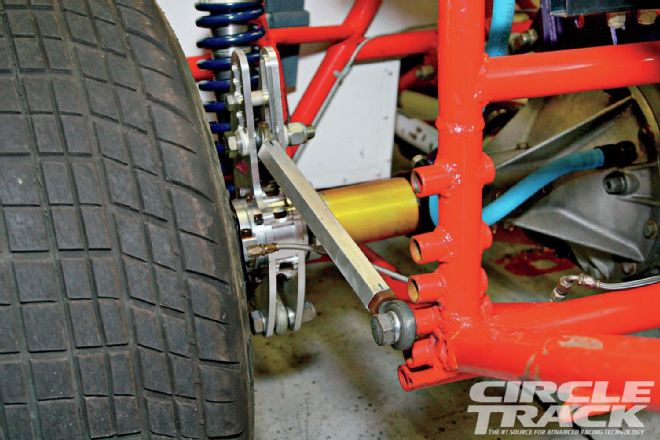 A Z-link suspension system uses a link extending from the under the rearend forward to the chassis and one from the top of the rearend rearward to a mount on the chassis. Most designs use very few mounting holes that would enable the team to adjust for the amount of rear steer in those cars. This one has quite a few.
A Z-link suspension system uses a link extending from the under the rearend forward to the chassis and one from the top of the rearend rearward to a mount on the chassis. Most designs use very few mounting holes that would enable the team to adjust for the amount of rear steer in those cars. This one has quite a few.
Measuring Your Rear Steer
To measure the rear steer in your car, first know the shock travels at each corner of the rear. Then you can recreate the rear attitude at mid-turn. You can use a tape measure for simple measurements or a laser system for more detailed analysis. With the tape, simply measure, at ride height, from the rear wheels toward the front of the car, level with the ground to a point. This can be a mark on a tape near the front wheel. For the laser systems, follow the manufacturers instructions.
Move the rear wheels in any increment you choose to the position they are at when the car is at mid-turn and remeasure the distances. If they are in opposite directions, add them to determine the amount of rear steer. If they are in the same direction, subtract them. You might be surprised at how much rear steer is going on.
We are finding ways to minimize rear steer on entry and through the middle of the turns, and then creating rear steer to the left to enhance bite off the corners through other means. Watch for articles in CT in the coming months that deal with this.